With International Womens Day on the 8th March, Select Car Leasing looked at 8 ways the automotive industry is still geared against women and how it can change for the better.
1) Crash Test Dummies Favour Men
As reported by Business Insider, American car companies use only one type of female test dummy, shes five feet tall and weighs 7.8 stone. An average American woman weighs 12.2 stone and stands nearly four inches taller than the test dummy. Female car-crash victims are more likely to die or suffer a serious injury in a collision regardless of other mitigating factors such as ability, the car model and seat belt usage. Incredibly, until 2003 only male test dummies were tested in vehicles.
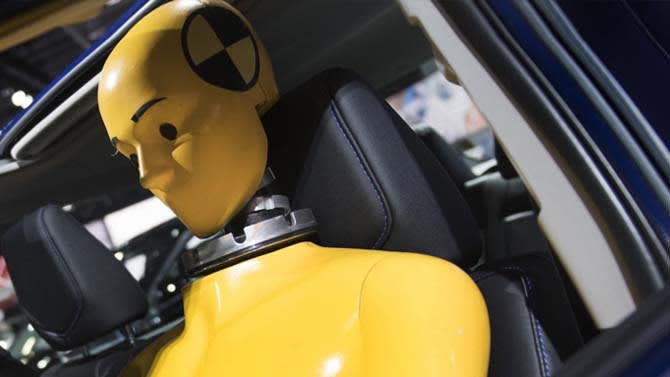
Dr David Lawrence, Director of the Centre for Injury Prevention Policy & Practice at San Diego State University, told ABC News in 2012 "Manufacturers and designers used to all be men. It didn't occur to them they should be designing for people unlike themselves. Well, we got over that." The need for a male and a female test dummy comes down to the "ways that men and women are different bio-mechanically," Jason Forman, a principal scientist at UVA's Centre for Applied Biomechanics and a study author, told CityLab.
Back in the EU - the situation isnt much better. According to the National Federation of Womens Institutes, Current EU regulatory crash test requirements define five tests that must be passed before a car is allowed onto the market. None of these tests are required to be carried out using an anthropometrically correct female dummy, whereas four out of the five tests specify the use of a 50th percentile male dummy. There is one regulatory test that requires the use of a 5th percentile female dummy, which is meant to represent the whole female population. This dummy is only tested in the passenger seat and no data is available on how a female driver would be affected.
2) Women 73% More Likely to Face Injuries During Crashes
Back in 2011, a study by the University of Virginia Centre for Applied Biomechanics revealed that female drivers involved in car crashes were 47% more likely to fall victim to a serious injury or death than their male counterparts. Its the same story when talking about moderate injuries, with the likelihood compared to men increasing to 71%. That landmark research was the first time this dangerous motoring gender divide in-car safety had ever been quantified.
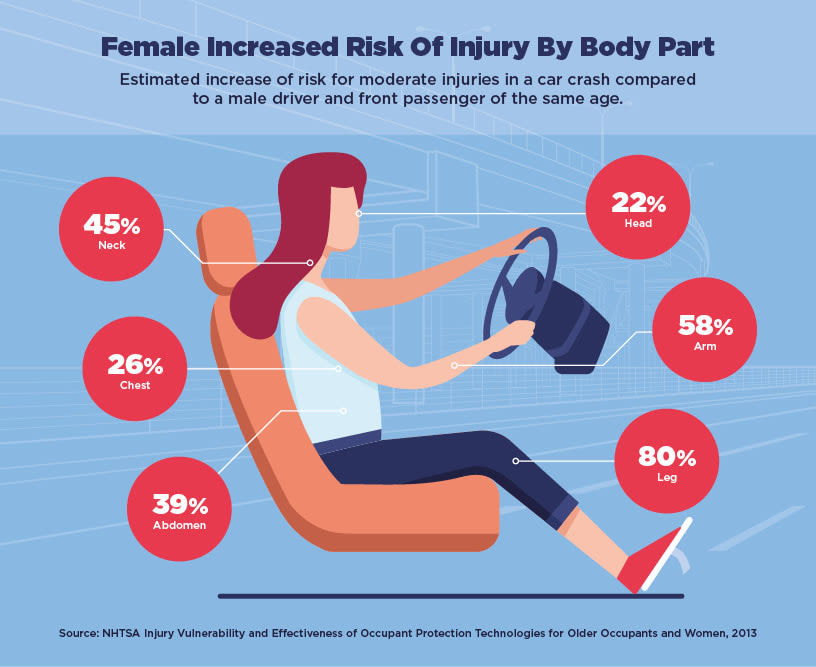
Fast forward to 2020 and the picture remains bleak. A new paper published by the University Of Virginia research team in 2019 has now found that the odds of a female sustaining a serious injury or death is 73%, or in other words 26% higher than in 2011. The latest study analysed 31,000 motorists between 1998 and 2015. It shows there has been no progress over the past 10 or so years in equalling the gender danger gap during car accidents.
This data is supported by research from the National Highway Traffic Safety Administration (NHTSA). They broke down the increased risk to females when in a car crash by body part. In some cases, such as leg injuries, females are an astounding8 0% more likely to get injured than their male counterparts during a car crash.
3) Seat Belts Dont Fit Pregnant Women
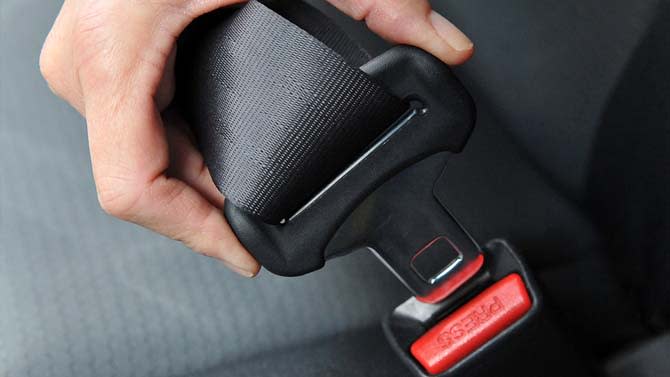
Although guidance from many automotive manufacturers and authorities is that standard seat belts are adequate for women to use when pregnant, research has shown that some are hesitant to use them because of the potential risk to their baby during a crash.
A recent study by Clippasafe of 500 mums found that 19% sometimes chose not to wear a seat belt at all during pregnancy because of discomfort, while four in five said they found it uncomfortable wearing a seatbelt but did so anyway. The biggest reason for this is that seatbelts that come as standard on cars currently dont fit most women during their third trimester.
In the book Invisible Women: Exposing Data Bias in a World Designed for Men, Caroline Criado Perez tells us that Although a pregnant crash-test dummy was created back in 1996, testing with it is still not government-mandated either in the US or in the EU. In fact, even though car crashes are the number 1 cause of fetal death related to maternal trauma, we havent yet developed a seatbelt that works for pregnant women. Research from 2004 suggests that pregnant women should use the standard seatbelt, but 62% of third-trimester pregnant women dont fit that design,
Due to this, a third-party offering has entered the market to correct the issue, but there is shockingly just ONE pregnancy seat belt positioner product on the market in the US, according to SafeRide4Kids.
4) Voice Recognition Doesnt Recognise Womens Voices
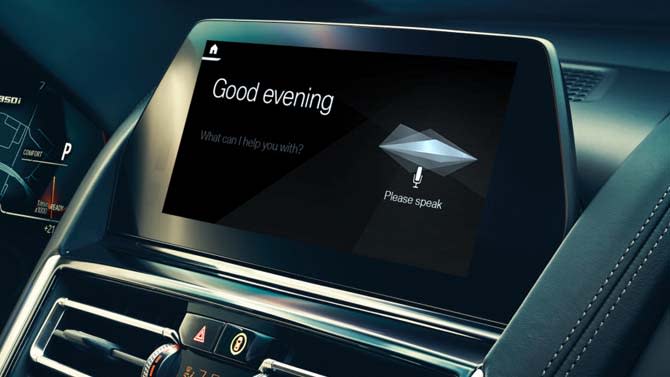
Automakers have admitted for a decade now that their voice recognition technology doesnt work as well for women as it does for men. Back in 2011, it was mooted that women should simply take training in order to adapt their voices to speech recognition technology. VP of Voice Technology for auto supplier ATX Group, Tom Schalk, said, many issues with womens voices could be fixed if female drivers were willing to sit through lengthy training Women could be taught to speak louder, and direct their voices towards the microphone. However, that solution seems like a lot of effort to give your car some simple commands and is highly insulting.
Another example of this bias in the wider world comes in the form of Googles voice recognition tech. According to Google, 20% of their searches are made by voice query and they estimate the number will rise to 50% by the end of 2020. This means that accurate tech will become more and more essential as we move forward into the next decade. However, in 2016, Rachael Tatman, a research fellow in linguistics at the University of Washington, found that Googles speech-recognition software was 70% more likely to accurately recognise male speech. This would put women at a disadvantage as speech recognition becomes the next big platform in the years to come, with it increasingly being used in cars to operate features.
Not only is it women who have this problem with voice recognition systems, but also people of both genders who have either a foreign or strong regional accent.
5) Only 1% Of Racing Drivers Are Women
![]()

In 2013, International Motorsport Hall Of Fame inductee Stirling Moss told the BBC on the question of female F1 drivers, I think they have the strength, but I don't know if they've got the mental aptitude to race hard, wheel-to-wheel. The trouble is, when you're racing, it's pretty tiring. The mental stress I think would be pretty difficult for a lady to deal with in a practical fashion. I just don't think they have the aptitude to win a Formula 1 race."
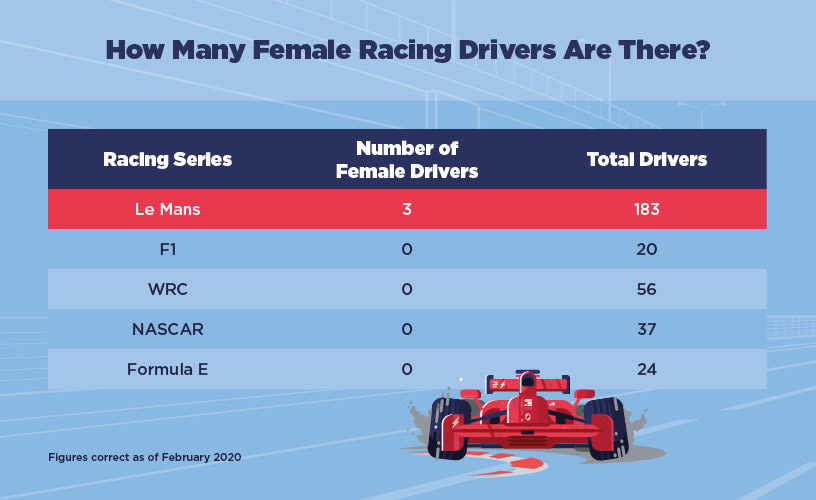
These comments were met with widespread discontent in the industry and further afield. Then hopeful F1 driver Susie Wolff, who has now retired from the sport, fired back, "I don't know where to start after hearing that interview. I've got a lot of respect for Sir Stirling and what he achieved, but I think we're in a different generation. For Moss, it's unbelievable that a female would drive a Formula 1 car, which is fair enough. In the days they were racing, every time they stepped into a car, they were putting their life on the line. But F1 is much more technologically advanced, it's much safer than it was."
Although that interview is now 7 years old, the situation remains the same for women in motorsport. Currently, in 5 of the biggest racing series in the world, there are only 3 female drivers.
Over those 5 racing disciplines, there is a total of 320 drivers but only 3 female participants who all belong to the same team, Kessel Racing. That means that only around 1% of drivers in those 5 disciplines are female.
6) Lack Of Women At Boardroom Level

Representation of women at boardroom level is a problem across most sectors of business, and its no different in motoring. Select Car Leasing looked at the CEOs of 20 of the worlds most well-known car companies and found that in only 3 cases that position was occupied by women. Mary Barra is the CEO of General Motors who own both Chevrolet and Buick, so in total only two women have the top job position in the 20 automotive companies below. You can find that research here.
In terms of the wider boardroom, recent research carried out by Just Tyres found that there was a disproportionately small number of women in executive positions as a whole, rather than just at CEO level.
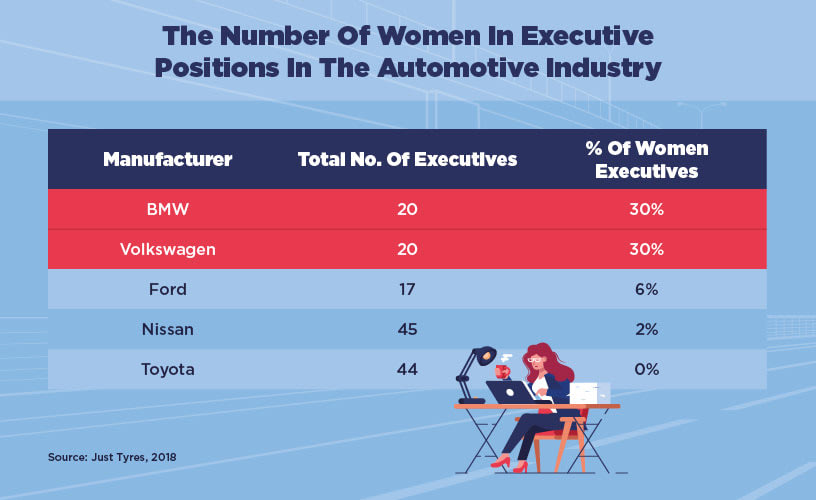
There are some positive signs in this regard. In 2018, General Motors became the first automotive company in history to have both a female CEO and CFO in Mary Barra and Dhivya Suryadevara respectively. However, these appointments have not dented the so-called glass ceiling and there is still a lot of work to be done until women are equally represented in automotive boardrooms.
7) Underrepresentation In Automotive Manufacturing
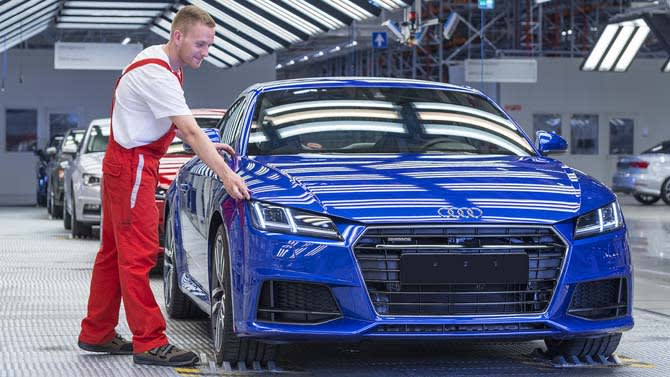
According to research carried out by Deloitte, women face substantial roadblocks in order to enter and succeed in the automotive industry. Are there underlying factors that have contributed to the creation of a male-dominated industry? The biggest one is that 65% of women find an automotive workplace unappealing, while most also avoid a career in the automotive industry because of the poor work/life balance.
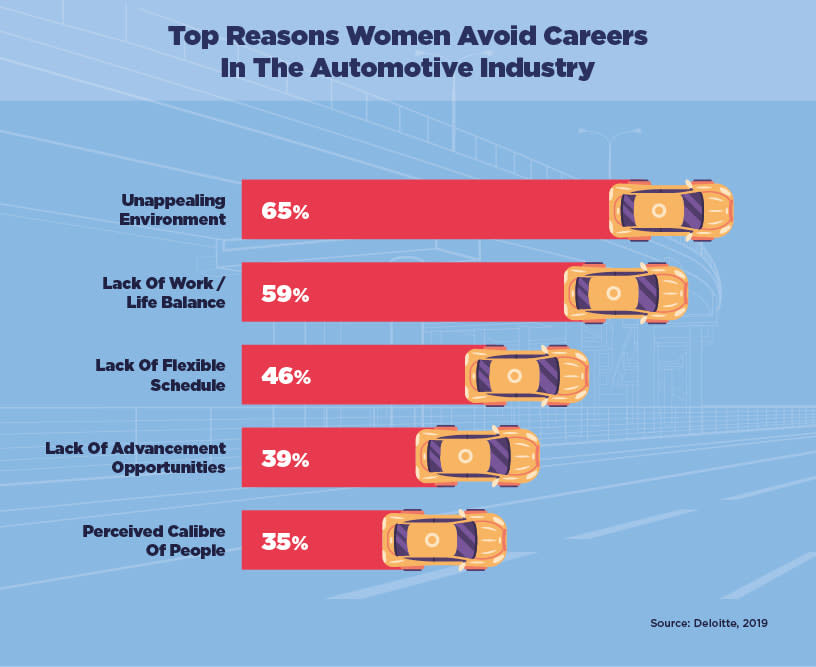
This has meant that there is a severe underrepresentation of women in the manufacturing side of the motoring industry, as well as the boardroom. Just 1 in 4 people employed in the EU in the manufacturing of motor vehicles are women, according to research conducted by Catalyst. Broken down specifically to each country, only 14% of employees involved in the manufacturing process of motor vehicles in the UK are women, while its only 12% in the Netherlands.
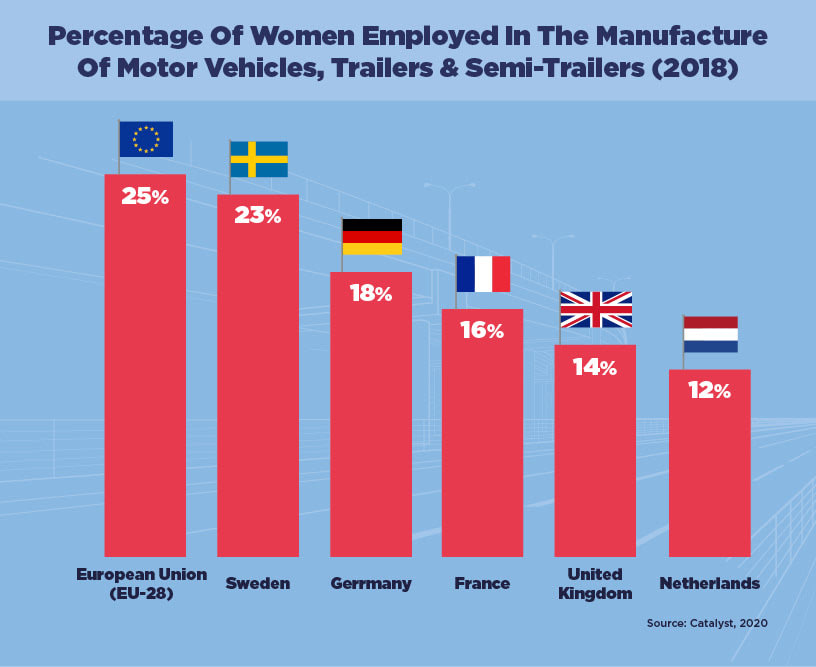
In the US, the situation is not much different. In 2019, women held 24% of jobs in the motor vehicle manufacturing industry. The automotive industry must improve and work to shake off its mans world reputation in order to attract more women to the manufacturing side of the sector.
8) Car Dealerships Are Hostile Towards Women

Car dealerships and showrooms can be a daunting experience for anyone, but especially for women due to the unequal treatment they receive. Womens magazine website Good Housekeeping conducted a survey of 2,600 women who had recently been looking for a car. It revealed some of the pitfalls of looking for a car as a woman. 66% of women believe that car showrooms could be more female-friendly, as most tend to have a male focus, similar to most car adverts on television. This is despite the fact that the final car buying decision is more often than not (53%) done with input from both partners and 43% of the time women make the decision alone.
The Good Housekeeping survey also revealed that 70% of car salespeople choose to address the men in their company rather than themselves, showing that they consider the male to be the car person - even though in only 5% of cases the man is the person who has the final say on the car purchasing decision. Almost half of women (49%) looking for a new car at a dealership find car sales staff patronising. One third would even say that they feel vulnerable and lack confidence when they visit car showrooms.

This has meant that women dont particularly want to visit car dealerships, with their partners or by themselves. A study conducted in 2016 asked 48,000 women in the UK about their experiences, and a staggering 90% told them that they wouldnt go into car dealerships by themselves because of the way they are treated.
Women in Motoring: How does the future look and how realistic is change?
Although there are some positive signs that the motor industry is moving in the right direction, there is still so much work to be done to counter the gender imbalance in the industry.
The sector continues to wrestle with its "mans world" image, an idea that's been in place since the boom of the motor car in the 50s and 60s, with little done to amend this. The first step must be a greater focus on gender equality in the industry from the largest manufacturers and industry bodies - car companies must put processes in place so that women can see a clear route of progression into positions of power. Change is realistic, recent signals from the world's largest manufacturer General Motors show this is possible. The American giant lead the way on gender equality, with women occupying two of the top jobs at the company, but for real change to take hold other manufacturers must follow suit and shape a fairer future. 2020 can be the year that the winds of change sweep the industry.
Sources:
https://www.businessinsider.com/women-dying-car-crashes-test-dummy-study-2019-7?r=US&IR=T
https://www.thewi.org.uk/__data/assets/pdf_file/0005/389084/Female-Crash-Test-Dummies.pdf
https://www.ncbi.nlm.nih.gov/pmc/articles/PMC3222446/
https://www.tandfonline.com/doi/pdf/10.1080/15389588.2019.1630825?needAccess=true&
https://crashstats.nhtsa.dot.gov/Api/Public/ViewPublication/811766
https://saferide4kids.com/blog/is-wearing-the-seat-belt-really-safe-for-pregnant-women/
https://makingnoiseandhearingthings.com/2016/07/12/googles-speech-recognition-has-a-gender-bias/
https://www.bbc.co.uk/sport/formula1/22083547
https://www.justtyres.co.uk/pages/where-are-all-the-women-in-the-automotive-industry
https://www.catalyst.org/research/women-in-the-automotive-industry/
https://crashstats.nhtsa.dot.gov/Api/Public/ViewPublication/811766














